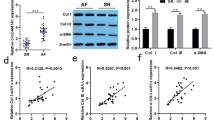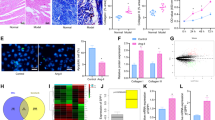Abstract
Atrial fibrosis is a hallmark of structural remodeling in atrial fibrillation (AF). MicroRNA-96 (miR-96) has been reported to be associated with pulmonary fibrosis and hepatic fibrosis. Nevertheless, the role of miR-96 in atrial fibrosis is still unclear. In our study, we showed that miR-96 is upregulated in human atrial tissues from AF patients and positively correlates with collagen I and collagen III levels. Knockdown of miR-96 reduced angiotensin II (Ang-II)-induced cardiac-fibroblast proliferation, migration, and collagen production, whereas ectopic expression of miR-96 yielded opposite results. Furthermore, we demonstrated that miR-96 represses KLF13 expression, subsequently promoting Ang-II-induced proliferation, migration, and collagen production in murine cardiac fibroblasts. Moreover, we observed that the knockdown of miR-96 attenuated the Ang-II-induced atrial fibrosis in a mouse model of AF. All the findings point to a potential target for the prevention or treatment of atrial fibrosis.





Similar content being viewed by others
Change history
01 September 2022
This article has been retracted. Please see the Retraction Notice for more detail: https://doi.org/10.1007/s13577-022-00780-8
References
January CT, Wann LS, Alpert JS, et al. 2014 AHA/ACC/HRS guideline for the management of patients with atrial fibrillation: a report of the American College of Cardiology/American Heart Association Task Force on Practice Guidelines and the Heart Rhythm Society. J Am Coll Cardiol. 2014;64:e1–76.
Hirsh BJ, Copeland-Halperin RS, Halperin JL. Fibrotic atrial cardiomyopathy, atrial fibrillation, and thromboembolism: mechanistic links and clinical inferences. J Am Coll Cardiol. 2015;65:2239–51.
Chugh SS, Havmoeller R, Narayanan K, et al. Worldwide epidemiology of atrial fibrillation: a Global Burden of Disease 2010 Study. Circulation. 2014;129:837–47.
Schotten U, Verheule S, Kirchhof P, et al. Pathophysiological mechanisms of atrial fibrillation: a translational appraisal. Physiol Rev. 2011;91:265–32525.
Dobrev D, Carlsson L, Nattel S. Novel molecular targets for atrial fibrillation therapy. Nat Rev Drug Discovery. 2012;11:275–91.
Dzeshka MS, Lip GY, Snezhitskiy V, et al. Cardiac fibrosis in patients with atrial fibrillation: mechanisms and clinical implications. J Am Coll Cardiol. 2015;66:943–59.
Dong Q, Li S, Wang W, et al. FGF23 regulates atrial fibrosis in atrial fibrillation by mediating the STAT3 and SMAD3 pathways. J Cell Physiol. 2019;234:19502–10.
Zhang W, Zhang T, Jin R, et al. MicroRNA-301a promotes migration and invasion by targeting TGFBR2 in human colorectal cancer. J Exp Clin Cancer Res. 2014;33:113.
Liu W, Zheng J, Dong J, et al. Association of miR-197-5p, a circulating biomarker for heart failure, with myocardial fibrosis and adverse cardiovascular events among patients with stage C or D heart failure. Cardiology. 2018;141:212–25.
Wang Y, Ma W, Lu S, et al. Androgen receptor regulates cardiac fibrosis in mice with experimental autoimmune myocarditis by increasing microRNA-125b expression. Biochem Biophys Res Commun. 2018;506:130–6.
Seo HH, Lee S, Lee CY, et al. Multipoint targeting of TGF-beta/Wnt transactivation circuit with microRNA 384-5p for cardiac fibrosis. Cell Death Differ. 2019;26:1107–23.
Luo X, Zhang D, Xie J, et al. MicroRNA-96 promotes schistosomiasis hepatic fibrosis in mice by suppressing Smad7. Mol Therapy Methods Clin Dev. 2018;11:73–82.
Nho RS, Im J, Ho YY, et al. MicroRNA-96 inhibits FoxO3a function in IPF fibroblasts on type I collagen matrix. Am J Physiol Lung Cell Mol Physiol. 2014;307:L632–L642642.
Fang L, Ellims AH, Moore XL, et al. Circulating microRNAs as biomarkers for diffuse myocardial fibrosis in patients with hypertrophic cardiomyopathy. J Transl Med. 2015;13:314.
Li PF, He RH, Shi SB, et al. Modulation of miR-10a-mediated TGF-beta1/Smads signaling affects atrial fibrillation-induced cardiac fibrosis and cardiac fibroblast proliferation. Biosci Rep. 2019;2019:39.
Xie H, Fu JL, Xie C. MiR-138-5p is downregulated in patients with atrial fibrillation and reverses cardiac fibrotic remodeling via repressing CYP11B2. Eur Rev Med Pharmacol Sci. 2018;22:4642–7.
Wang Y, Cai H, Li H, et al. Atrial overexpression of microRNA-27b attenuates angiotensin II-induced atrial fibrosis and fibrillation by targeting ALK5. Hum Cell. 2018;31:251–60.
Huang Y, Zhu N, Chen T, et al. Triptolide suppressed the microglia activation to improve spinal cord injury through miR-96/IKKbeta/NF-kappaB pathway. Spine. 2019;44:E707–E714714.
Chao L, Hua-Yu Z, Wen-Dong B, et al. miR-96 promotes collagen deposition in keloids by targeting Smad7. Exp Therapeutic Med. 2019;17:773–81.
He C, Zhang Q, Gu R, et al. miR-96 regulates migration and invasion of bladder cancer through epithelial-mesenchymal transition in response to transforming growth factor-beta1. J Cell Biochem. 2018;119:7807–17.
Yang M, Pan Y, Zhou Y. miR-96 promotes osteogenic differentiation by suppressing HBEGF-EGFR signaling in osteoblastic cells. FEBS Lett. 2014;588:4761–8.
Lau DH, Schotten U, Mahajan R, et al. Novel mechanisms in the pathogenesis of atrial fibrillation: practical applications. Eur Heart J. 2016;37:1573–81.
Ambros V. The functions of animal microRNAs. Nature. 2004;431:350–5.
McConnell BB, Yang VW. Mammalian Kruppel-like factors in health and diseases. Physiol Rev. 2010;90:1337–811.
Shindo T, Manabe I, Fukushima Y, et al. Kruppel-like zinc-finger transcription factor KLF5/BTEB2 is a target for angiotensin II signaling and an essential regulator of cardiovascular remodeling. Nat Med. 2002;8:856–63.
Derwinska K, Bartnik M, Wisniowiecka-Kowalnik B, et al. Assessment of the role of copy-number variants in 150 patients with congenital heart defects. Medycyna Wieku Rozwojowego. 2012;16:175–82.
Cruz-Topete D, He B, Xu X, Cidlowski JA. Kruppel-like factor 13 Is a major mediator of glucocorticoid receptor signaling in cardiomyocytes and protects these cells from DNA damage and death. J Biol Chem. 2016;291:19374–86.
Lavallee G, Andelfinger G, Nadeau M, et al. The Kruppel-like transcription factor KLF13 is a novel regulator of heart development. EMBO J. 2006;25:5201–13.
Author information
Authors and Affiliations
Corresponding author
Ethics declarations
Conflict of interest
The authors confirm that there are no conflicts of interest.
Ethical standards
All animal experiments were performed in accordance with the institutional guidelines from the Care and Use of Laboratory Animals of Shu Guang Hospital Affiliated to Shanghai University of Traditional Chinese Medicine and were approved by the Institutional Animal Ethics Committee.
Additional information
Publisher's Note
Springer Nature remains neutral with regard to jurisdictional claims in published maps and institutional affiliations.
This article has been retracted. Please see the retraction notice for more detail: https://doi.org/10.1007/s13577-022-00780-8
Rights and permissions
Springer Nature or its licensor holds exclusive rights to this article under a publishing agreement with the author(s) or other rightsholder(s); author self-archiving of the accepted manuscript version of this article is solely governed by the terms of such publishing agreement and applicable law.
About this article
Cite this article
Su, L., Yao, Y. & Song, W. RETRACTED ARTICLE: Downregulation of miR-96 suppresses the profibrogenic functions of cardiac fibroblasts induced by angiotensin II and attenuates atrial fibrosis by upregulating KLF13. Human Cell 33, 337–346 (2020). https://doi.org/10.1007/s13577-020-00326-w
Received:
Accepted:
Published:
Issue Date:
DOI: https://doi.org/10.1007/s13577-020-00326-w




